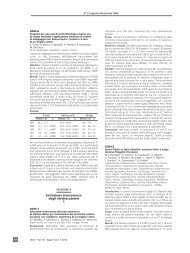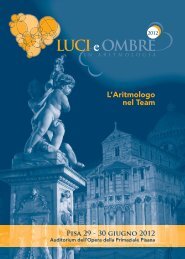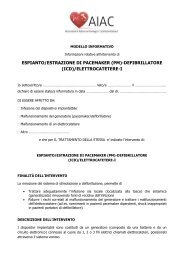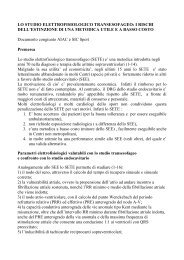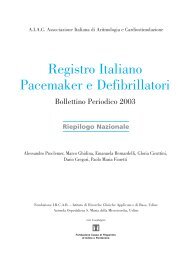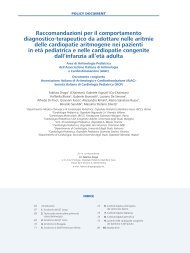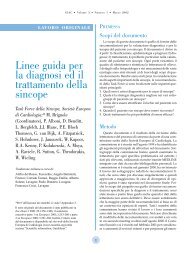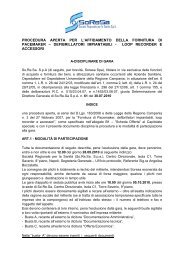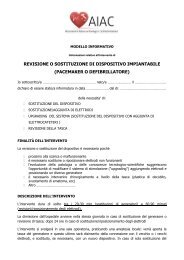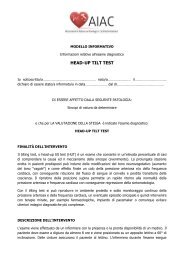Testo completo - Associazione Italiana di Aritmologia e ...
Testo completo - Associazione Italiana di Aritmologia e ...
Testo completo - Associazione Italiana di Aritmologia e ...
Create successful ePaper yourself
Turn your PDF publications into a flip-book with our unique Google optimized e-Paper software.
stico quale causa della sincope. (15-17) Questo blocco è,<br />
verosimilmente, la causa della sincope nella maggior<br />
parte dei casi, sebbene non influenzi l’alto grado <strong>di</strong> mortalità<br />
in questi pazienti. (5-7,11,18,19-21) Infatti, l’alta mortalità<br />
sembra maggiormente correlata alla gravità della<br />
car<strong>di</strong>opatia <strong>di</strong> base e a tachiaritmie ventricolari.<br />
Sfortunatamente, la stimolazione ventricolare programmata<br />
raramente identifica questi pazienti. (22,23)<br />
Raccomandazioni per l’impianto<br />
<strong>di</strong> pacemaker nei blocchi<br />
fascicolari cronici<br />
Classe I<br />
1. Blocco <strong>di</strong> branca alternante.<br />
2. Blocco bifascicolare con BAV <strong>di</strong> II Mobitz II o BAV<br />
<strong>di</strong> III grado intermittenti.<br />
Classe II<br />
1. Sincope <strong>di</strong> natura indeterminata in cui siano escluse<br />
altre cause, in particolare TV.<br />
2. Riscontro accidentale allo SEF <strong>di</strong> HV ≥100 msec o <strong>di</strong><br />
BAV sottohisiano indotto da pacing.<br />
3. Malattie neuromuscolari (es. <strong>di</strong>strofia muscolare miotonica,<br />
sindrome <strong>di</strong> Kearns-Sayre, <strong>di</strong>strofia <strong>di</strong> Erb) e<br />
atrofia muscolare peroneale, in presenza <strong>di</strong> qualsiasi<br />
grado <strong>di</strong> blocco fascicolare, in presenza o assenza<br />
<strong>di</strong> sintomi, a causa dell’impreve<strong>di</strong>bilità della progressione<br />
della malattia.<br />
Bibliografia<br />
1) Zoni Berisso M, et al.: Linee Guida alla stimolazione car<strong>di</strong>aca<br />
definitiva. Italian Heart J Suppl Vol 1 Aprile 2000.<br />
2) ACC/AHA/NASPE 2002 Guideline Update for Implantation of<br />
Car<strong>di</strong>ac Pacemakers and Antiarrhythmia Devices. Circulation<br />
2002, Oct 15; 106(16):2145-61.<br />
3) ESC Guidelines on Management Diagnosis and Treatment of<br />
Sincope – Update 2004. Europace 2004;6 (6):467-537<br />
4) Delise P: Aritmie: <strong>di</strong>agnosi, prognosi e terapia. Casa E<strong>di</strong>trice<br />
Scientifica Internazionale. 2004<br />
5) Bergfeldt L, Edvardsson N, Rosenqvist M, et al.: Atrioventricular<br />
block progression in patients with bifascicular block assessed<br />
by repeated electrocar<strong>di</strong>ography and a bradycar<strong>di</strong>a-detecting<br />
pacemaker. Am J Car<strong>di</strong>ol 1994; 74: 1129-32.<br />
6) McAnulty JH, Rahimtoola SH, Murphy E, et al.: Natural history<br />
of „high risk“ bundle branch block. Final report of a prospective<br />
study. N Engl J Med 1982;307:137– 43.<br />
7) Scheinman MM, Peters RW, Sauvé MJ, et al.: Value of the H–Q<br />
GIAC • Volume 8 • Numero 4 • Dicembre 2005<br />
8<br />
interval in patients with bundle branch block and the role of prophylactic<br />
permanent pacing. Am J Car<strong>di</strong>ol 1982;50:1316– 22.<br />
8) Rosen KM, Rahimtoola SH, Chquimia R, et al.:<br />
Electrophysiological significance of first-degree atrio-ventricular<br />
block with intraventricular conduction <strong>di</strong>sturbance. Circulation<br />
1971; 43:491-502<br />
9) Dhingra RC, Wyndham C, Bauernfeind R, et al.: Significance<br />
of block <strong>di</strong>stal to the His bundle induced by atrial pacing in<br />
patients with chronic bifascicular block. Circulation 1979;<br />
60:1455-1464<br />
10) Petrac D, Ra<strong>di</strong>c B, Birtic K, et al.: Prospective evaluation of<br />
infrahisian second degree AV block induced by atrial pacing<br />
in the presence of chronic bundle branch block and syncope.<br />
Pacing Clin Electrophisiol 1996; 19:679-687<br />
11) Click R, Gersh B, Sugrue D, et al.: Role of invasive electrophysiologic<br />
testing in patients with symptomatic bundle branch<br />
block. Am J Car<strong>di</strong>ol 1987; 59:817-823<br />
12) Gronda M, Magnani A, Occhetta E, et al.: Electrophysiologic<br />
study of atrioventricular block and ventricular conduction<br />
defects. G Ital Car<strong>di</strong>ol 1984; 14: 768-773<br />
13) Dini P, Iaolongo D, A<strong>di</strong>nolfi E, et al.: Prognostic value of Hisventricular<br />
conduction after ajmaline administration. In: Masoni<br />
A, Alboni P, e<strong>di</strong>tors. Car<strong>di</strong>ac Electrophysiology today. London:<br />
Academic Press; 1982. p. 515-522.<br />
14) Englund A., Bergfeldt L, Rosenqvist N: Pharmacological stress<br />
testing of the His-Purkinje system in patients with bifascicular<br />
block. Pacing Clin Electrophysiol 1998; 21:1979-1987<br />
15) Link M, Kim KM, Homoud M, et al.: Long-term outcome of<br />
patients with syncope associated with coronary <strong>di</strong>sease and a<br />
non-<strong>di</strong>agnostic electrophysiological evaluation. Am J Car<strong>di</strong>ol<br />
1999;83:1334–7.<br />
16) Gaggioli G, Bottoni N, Brignole M, et al.: Progression to second-<br />
or third degree atrioventricular block in patients electrostimulated<br />
for bundle branch block: a long-term study. G Ital<br />
Car<strong>di</strong>ol 1994;24: 409– 16.<br />
17) Brignole M, Menozzi C, Moya A, et al.: Mechanism of syncope<br />
in patients with bundle branch block and negative electrophysiological<br />
test. Circulation 2001;104:2045– 50.<br />
18) Kaul U, Dev V, Narula J, et al.: Evaluation of patients with bundle<br />
branch block and “unexplained” syncope: a study based on<br />
comprehensive electrophysiologic testing and ajmaline stress.<br />
Pacing Clin Electrophysiol 1988; 11: 289-297.<br />
19) Gaggioli G, Bottoni N, Brignole M, et al.: Progression to second<br />
or third degree atrioventricular block in patients electrostimulated<br />
for bundle branck block: a long term study. G Ital<br />
Car<strong>di</strong>ol 1994; 24:409-416.<br />
20) Dhingra RC, Palileo E, Strasberg B, et al.: Significance of the<br />
HV interval in 517 patients with chronic bifascicular block.<br />
Circulation 1981; 64: 1265-71.<br />
21) Englund A, Bergfeldt L, Rehnqvist N et al.: Diagnostic value<br />
of programmed ventricular stimulation in patients with bifascicular<br />
block: a prospective study of patients with and without<br />
syncope. J Am Coll Car<strong>di</strong>ol 1995; 26:1508-1515.<br />
22) Morandy F; Higgins J; Peters R, et al.: Electrophysiologic testing<br />
in bundle branch block and unexplained syncope. Am J<br />
Car<strong>di</strong>ol 1984; 54: 587-591.<br />
23) Nierop P, Vam Mechelen R, Elsacker A, et al.: Heart rhythm<br />
during syncope and presyncope. Pacing Clin Electrophysiol 2000;<br />
23: 1532-1538.



